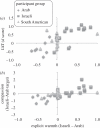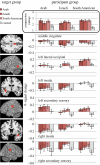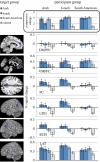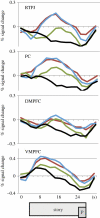Social cognition in members of conflict groups: behavioural and neural responses in Arabs, Israelis and South Americans to each other's misfortunes
- PMID: 22271787
- PMCID: PMC3260847
- DOI: 10.1098/rstb.2011.0293
Social cognition in members of conflict groups: behavioural and neural responses in Arabs, Israelis and South Americans to each other's misfortunes
Abstract
In contexts of cultural conflict, people delegitimize the other group's perspective and lose compassion for the other group's suffering. These psychological biases have been empirically characterized in intergroup settings, but rarely in groups involved in active conflict. Similarly, the basic brain networks involved in recognizing others' narratives and misfortunes have been identified, but how these brain networks are modulated by intergroup conflict is largely untested. In the present study, we examined behavioural and neural responses in Arab, Israeli and South American participants while they considered the pain and suffering of individuals from each group. Arabs and Israelis reported feeling significantly less compassion for each other's pain and suffering (the 'conflict outgroup'), but did not show an ingroup bias relative to South Americans (the 'distant outgroup'). In contrast, the brain regions that respond to others' tragedies showed an ingroup bias relative to the distant outgroup but not the conflict outgroup, particularly for descriptions of emotional suffering. Over all, neural responses to conflict group members were qualitatively different from neural responses to distant group members. This is the first neuroimaging study to examine brain responses to others' suffering across both distant and conflict groups, and provides a first step towards building a foundation for the biological basis of conflict.
Figures








Similar articles
-
Attitudes towards the outgroup are predicted by activity in the precuneus in Arabs and Israelis.Neuroimage. 2010 Oct 1;52(4):1704-11. doi: 10.1016/j.neuroimage.2010.05.057. Epub 2010 May 25. Neuroimage. 2010. PMID: 20510370
-
Adolescents growing up amidst intractable conflict attenuate brain response to pain of outgroup.Proc Natl Acad Sci U S A. 2016 Nov 29;113(48):13696-13701. doi: 10.1073/pnas.1612903113. Epub 2016 Nov 14. Proc Natl Acad Sci U S A. 2016. PMID: 27849588 Free PMC article.
-
Cultural influences on neural basis of intergroup empathy.Neuroimage. 2011 Jul 15;57(2):642-50. doi: 10.1016/j.neuroimage.2011.04.031. Epub 2011 Apr 29. Neuroimage. 2011. PMID: 21549201
-
Psychological Aspects of the Israeli-Palestinian Conflict: A Systematic Review.Trauma Violence Abuse. 2017 Jul;18(3):322-338. doi: 10.1177/1524838015613774. Epub 2015 Oct 27. Trauma Violence Abuse. 2017. PMID: 26511933
-
Neurocognitive Basis of Racial Ingroup Bias in Empathy.Trends Cogn Sci. 2018 May;22(5):400-421. doi: 10.1016/j.tics.2018.02.013. Epub 2018 Mar 18. Trends Cogn Sci. 2018. PMID: 29563059 Review.
Cited by
-
No evidence of theory of mind reasoning in the human language network.Cereb Cortex. 2023 May 9;33(10):6299-6319. doi: 10.1093/cercor/bhac505. Cereb Cortex. 2023. PMID: 36585774 Free PMC article.
-
Deeper Than You Think: Partisanship-Dependent Brain Responses in Early Sensory and Motor Brain Regions.J Neurosci. 2023 Feb 8;43(6):1027-1037. doi: 10.1523/JNEUROSCI.0895-22.2022. Epub 2023 Jan 4. J Neurosci. 2023. PMID: 36599681 Free PMC article.
-
fMRI Repetition Suppression During Generalized Social Categorization.Sci Rep. 2017 Jun 27;7(1):4262. doi: 10.1038/s41598-017-04115-8. Sci Rep. 2017. PMID: 28655903 Free PMC article.
-
Effects of early adversity and social discrimination on empathy for complex mental states: An fMRI investigation.Sci Rep. 2019 Sep 10;9(1):12959. doi: 10.1038/s41598-019-49298-4. Sci Rep. 2019. PMID: 31506497 Free PMC article.
-
The neural development of empathy is sensitive to caregiving and early trauma.Nat Commun. 2019 Apr 23;10(1):1905. doi: 10.1038/s41467-019-09927-y. Nat Commun. 2019. PMID: 31015471 Free PMC article.
References
-
- Bar-Tal D. 2007. Sociopsychological foundations of intractable conflicts. Am. Behav. Sci. 50, 1430–145310.1177/0002764207302462 (doi:10.1177/0002764207302462) - DOI - DOI
-
- Krueger J. I., Funder D. C. 2004. Towards a balanced social psychology: causes, consequences, and cures for the problem-seeking approach to social behavior and cognition. Behav. Brain Sci. 27, 313–327 - PubMed
-
- Ross L., Stillinger C. 1991. Barriers to conflict resolution. Negot. J. 7, 389–40410.1111/j.1571-9979.1991.tb00634.x (doi:10.1111/j.1571-9979.1991.tb00634.x) - DOI - DOI
-
- Ross L. 1995. Reactive devaluation in negotiation and conflict resolution. In Barriers to Conflict Resolution (eds Arrow K., Mnookin R. H., Ross L., Tversky A., Wilson R.), pp. 26–43 New York, NY: W. W. Norton
-
- Kennedy K. A., Pronin E. 2008. When disagreement gets ugly: perceptions of bias and the escalation of conflict. Pers. Soc. Psychol. Bull. 34, 833–84810.1177/0146167208315158 (doi:10.1177/0146167208315158) - DOI - DOI - PubMed
Publication types
MeSH terms
LinkOut - more resources
Full Text Sources
Medical

